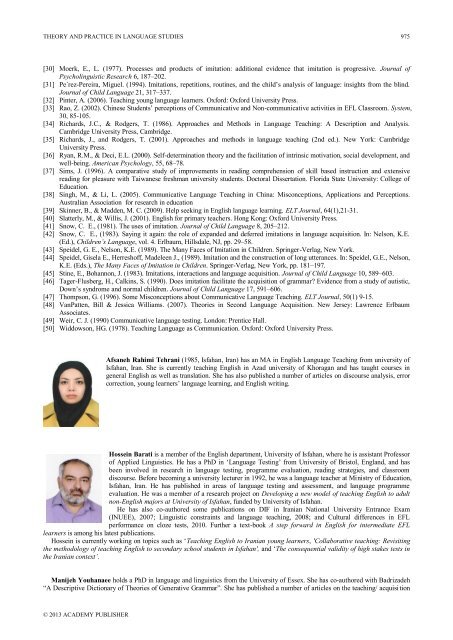Theory and Practice in Language Studies Contents - Academy ...
Theory and Practice in Language Studies Contents - Academy ...
Theory and Practice in Language Studies Contents - Academy ...
Create successful ePaper yourself
Turn your PDF publications into a flip-book with our unique Google optimized e-Paper software.
THEORY AND PRACTICE IN LANGUAGE STUDIES 975[30] Moerk, E., L. (1977). Processes <strong>and</strong> products of imitation: additional evidence that imitation is progressive. Journal ofPsychol<strong>in</strong>guistic Research 6, 187–202.[31] Pe´rez-Pereira, Miguel. (1994). Imitations, repetitions, rout<strong>in</strong>es, <strong>and</strong> the child‟s analysis of language: <strong>in</strong>sights from the bl<strong>in</strong>d.Journal of Child <strong>Language</strong> 21, 317–337.[32] P<strong>in</strong>ter, A. (2006). Teach<strong>in</strong>g young language learners. Oxford: Oxford University Press.[33] Rao, Z. (2002). Ch<strong>in</strong>ese Students‟ perceptions of Communicative <strong>and</strong> Non-communicative activities <strong>in</strong> EFL Classroom. System,30, 85-105.[34] Richards, J.C., & Rodgers, T. (1986). Approaches <strong>and</strong> Methods <strong>in</strong> <strong>Language</strong> Teach<strong>in</strong>g: A Description <strong>and</strong> Analysis.Cambridge University Press, Cambridge.[35] Richards, J., <strong>and</strong> Rodgers, T. (2001). Approaches <strong>and</strong> methods <strong>in</strong> language teach<strong>in</strong>g (2nd ed.). New York: CambridgeUniversity Press.[36] Ryan, R.M., & Deci, E.L. (2000). Self-determ<strong>in</strong>ation theory <strong>and</strong> the facilitation of <strong>in</strong>tr<strong>in</strong>sic motivation, social development, <strong>and</strong>well-be<strong>in</strong>g. American Psychology, 55, 68–78.[37] Sims, J. (1996). A comparative study of improvements <strong>in</strong> read<strong>in</strong>g comprehension of skill based <strong>in</strong>struction <strong>and</strong> extensiveread<strong>in</strong>g for pleasure with Taiwanese freshman university students. Doctoral Dissertation. Florida State University: College ofEducation.[38] S<strong>in</strong>gh, M., & Li, L. (2005). Communicative <strong>Language</strong> Teach<strong>in</strong>g <strong>in</strong> Ch<strong>in</strong>a: Misconceptions, Applications <strong>and</strong> Perceptions.Australian Association for research <strong>in</strong> education[39] Sk<strong>in</strong>ner, B., & Madden, M. C. (2009). Help seek<strong>in</strong>g <strong>in</strong> English language learn<strong>in</strong>g. ELT Journal, 64(1),21-31.[40] Slatterly, M., & Willis, J. (2001). English for primary teachers. Hong Kong: Oxford University Press.[41] Snow, C. E., (1981). The uses of imitation. Journal of Child <strong>Language</strong> 8, 205–212.[42] Snow, C. E., (1983). Say<strong>in</strong>g it aga<strong>in</strong>: the role of exp<strong>and</strong>ed <strong>and</strong> deferred imitations <strong>in</strong> language acquisition. In: Nelson, K.E.(Ed.), Children’s <strong>Language</strong>, vol. 4. Erlbaum, Hillsdale, NJ, pp. 29–58.[43] Speidel, G. E., Nelson, K.E. (1989). The Many Faces of Imitation <strong>in</strong> Children. Spr<strong>in</strong>ger-Verlag, New York.[44] Speidel, Gisela E., Herreshoff, Madeleen J., (1989). Imitation <strong>and</strong> the construction of long utterances. In: Speidel, G.E., Nelson,K.E. (Eds.), The Many Faces of Imitation <strong>in</strong> Children. Spr<strong>in</strong>ger-Verlag, New York, pp. 181–197.[45] St<strong>in</strong>e, E., Bohannon, J. (1983). Imitations, <strong>in</strong>teractions <strong>and</strong> language acquisition. Journal of Child <strong>Language</strong> 10, 589–603.[46] Tager-Flusberg, H., Calk<strong>in</strong>s, S. (1990). Does imitation facilitate the acquisition of grammar? Evidence from a study of autistic,Down‟s syndrome <strong>and</strong> normal children. Journal of Child <strong>Language</strong> 17, 591–606.[47] Thompson, G. (1996). Some Misconceptions about Communicative <strong>Language</strong> Teach<strong>in</strong>g. ELT Journal, 50(1) 9-15.[48] VanPatten, Bill & Jessica Williams. (2007). Theories <strong>in</strong> Second <strong>Language</strong> Acquisition. New Jersey: Lawrence ErlbaumAssociates.[49] Weir, C. J. (1990) Communicative language test<strong>in</strong>g. London: Prentice Hall.[50] Widdowson, HG. (1978). Teach<strong>in</strong>g <strong>Language</strong> as Communication. Oxford: Oxford University Press.Afsaneh Rahimi Tehrani (1985, Isfahan, Iran) has an MA <strong>in</strong> English <strong>Language</strong> Teach<strong>in</strong>g from university ofIsfahan, Iran. She is currently teach<strong>in</strong>g English <strong>in</strong> Azad university of Khoragan <strong>and</strong> has taught courses <strong>in</strong>general English as well as translation. She has also published a number of articles on discourse analysis, errorcorrection, young learners‟ language learn<strong>in</strong>g, <strong>and</strong> English writ<strong>in</strong>g.Hosse<strong>in</strong> Barati is a member of the English department, University of Isfahan, where he is assistant Professorof Applied L<strong>in</strong>guistics. He has a PhD <strong>in</strong> „<strong>Language</strong> Test<strong>in</strong>g‟ from University of Bristol, Engl<strong>and</strong>, <strong>and</strong> hasbeen <strong>in</strong>volved <strong>in</strong> research <strong>in</strong> language test<strong>in</strong>g, programme evaluation, read<strong>in</strong>g strategies, <strong>and</strong> classroomdiscourse. Before becom<strong>in</strong>g a university lecturer <strong>in</strong> 1992, he was a language teacher at M<strong>in</strong>istry of Education,Isfahan, Iran. He has published <strong>in</strong> areas of language test<strong>in</strong>g <strong>and</strong> assessment, <strong>and</strong> language programmeevaluation. He was a member of a research project on Develop<strong>in</strong>g a new model of teach<strong>in</strong>g English to adultnon-English majors at University of Isfahan, funded by University of Isfahan.He has also co-authored some publications on DIF <strong>in</strong> Iranian National University Entrance Exam(INUEE), 2007; L<strong>in</strong>guistic constra<strong>in</strong>ts <strong>and</strong> language teach<strong>in</strong>g, 2008; <strong>and</strong> Cultural differences <strong>in</strong> EFLperformance on cloze tests, 2010. Further a text-book A step forward <strong>in</strong> English for <strong>in</strong>termediate EFLlearners is among his latest publications.Hosse<strong>in</strong> is currently work<strong>in</strong>g on topics such as „Teach<strong>in</strong>g English to Iranian young learners, 'Collaborative teach<strong>in</strong>g: Revisit<strong>in</strong>gthe methodology of teach<strong>in</strong>g English to secondary school students <strong>in</strong> Isfahan', <strong>and</strong> „The consequential validity of high stakes tests <strong>in</strong>the Iranian context’.Manijeh Youhanaee holds a PhD <strong>in</strong> language <strong>and</strong> l<strong>in</strong>guistics from the University of Essex. She has co-authored with Badrizadeh“A Descriptive Dictionary of Theories of Generative Grammar”. She has published a number of articles on the teach<strong>in</strong>g/ acquisition© 2013 ACADEMY PUBLISHER
















